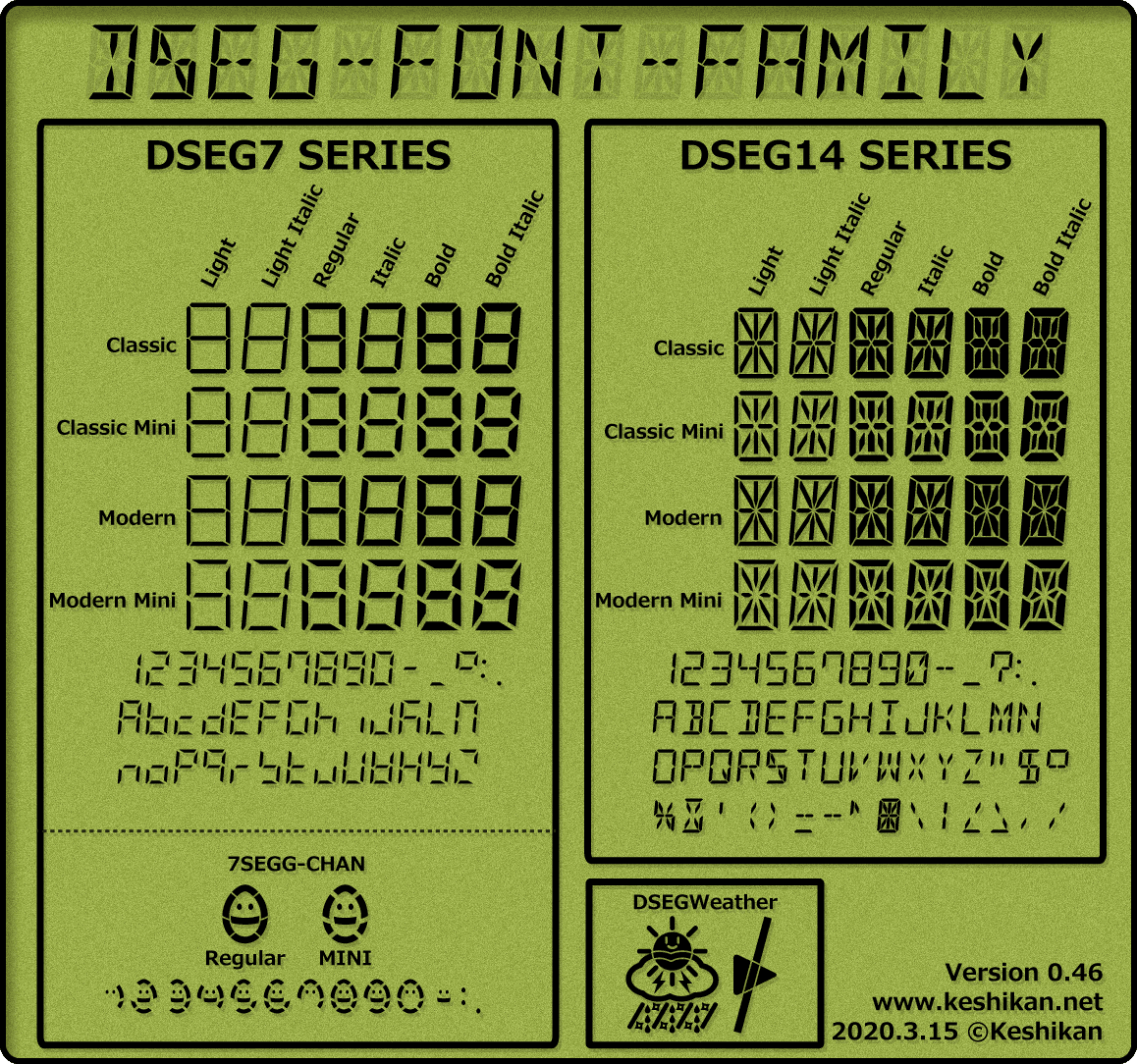
7 Segment Display Fonts
I am quite a fan of the Arduino as there is so much software already available on the internet, this makes completing new projects easier! Recently I bought a few cheap 1.8' TFT displays for a project, initially I could not get them working which was frustrating. Eventually I found that the ones I had bought used the Samsung S6D02A1 driver chip and I had been trying to use the wrong library. After a brief search on the web I came across the Adafruit_QDTech library which worked really well.
474 0 74 2 Published: 2nd July, 2013 Last edited: 22nd March, 2014 Created: 2nd July, 2013 Clone of 7 Segment Display by BernardTeo, which was a clone of segment by Mylicia. I liked the work done by Mylicia & BernardTeo, but I needed to extend it to the rest of the alphabet. 7-segment font - Open Font Library. Segment7: Strictly seven-segment (plus point) calculator display face, fixed-width and free. Other LED/LCD digital fonts may kern or include paths that are not.
This library is used in conjunction with the Adafruit_GFX library. After trying some examples I was a little disappointed that only scaled blocky fonts were available - so I have modified the original libraries to add some new fonts and functions. Update 2/2/2015: I have now added a driver library below for the 2.2' TFT QVGA 240x320 pixel display with the ILI9341 driver. This has examples included. Update 3/2/2015: I have now added a driver library for the 1.8' TFT display based on the ST7735 driver along with examples.
Update 14/6/2015: I have added a new library for the 2.2' TFT QVGA 240x320 pixel display with the ILI9341 driver. This library is called TFT_ILI9341 and is a stand alone library that does not need the support of another GFX library. Compatibility with the Adafruit GFX library has been maintained. See Step 8 of this Instructable. I have modified the Adafruit libraries and added the fonts.
The fonts will be stored in FLASH so will use up some program space however a reasonable amount of space is still available, if you run out then use an Arduino Mega board. I am actually a hardware designer so the software updates could probably be improved, but they are working! The zip file contains the two libraries you will need. These have have new names (_AS appended) so they will coexist with any libraries you already have. There are 3 example programs included in the Adafruit_QDTech_AS library. I updated the libraries to version 5 on 2/2/2015, now individual fonts can be disabled to save FLASH memory if they are not all needed. To prevent particular font files being loaded simply edit the 'Load_fonts.h' file within the 'Adafruit_GFX_AS' library folder.
Just comment out the fonts not needed by adding // to the beginning of the respective line. Also, in response to a question from a reader below, I have made the proportional fonts scalable just like the original simple Adafruit, this makes the fonts more blocky but providing the scale factor is not more than 2 the fonts still look reasonable. In the example TFT_Show_Font_ILI9341 I use the commands: tft.setTextSize(1); // For normal sized fonts tft.setTextSize(2); // For double sized fonts Other minor tweaks have been made so that the font background will be drawn as per original Adafruit font. The font drawing speed has also been improved. Minor tweaks have been made to the fonts, Font 4 has been reduced in height slightly to remove superfluous 'whitespace' and a full stop '.'
Has been added to the characters available in the large font 6. Minor tweaks to the fonts have been made and new example sketches have been added to show all font characters. Attachments •. Rob papen linplug albino vsti v302 incl keygen beat. Here are the library functions that can be called: • int drawUnicode(unsigned int uniCode, int x, int y, int size); • int drawNumber(long long_num,int poX, int poY, int size); • int drawChar(char c, int x, int y, int size); • int drawString(char *string, int poX, int poY, int size); • int drawCentreString(char *string, int dX, int poY, int size); • int drawRightString(char *string, int dX, int poY, int size); • int drawFloat(float floatNumber,int decimal,int poX, int poY, int size); In summary, the X and Y parameters are the coordinates for the drawing.
Each function returns the X position delta to the end of the printed characters. 'size' is the font size: • Only font numbers 2,4,6,7 are valid • Font 6 only contains characters [space] 0 1 2 3 4 5 6 7 8 9 -.: a p m • Font 7 is a 7 segment font and only contains characters [space] 0 1 2 3 4 5 6 7 8 9:. The fonts are proportionally spaced to give an improved appearance. Kpg 49d 420 download. The routine for floating point numbers uses a parameter 'decimal' which defines the number of decimal places to show, this aids formatting and displaying sensor readings, the number is rounded, so for example if decimal = 3, then 3.14159 will display as 3.142 and 3.14 will display as 3.140 drawCentreString will centre the string around the x position.